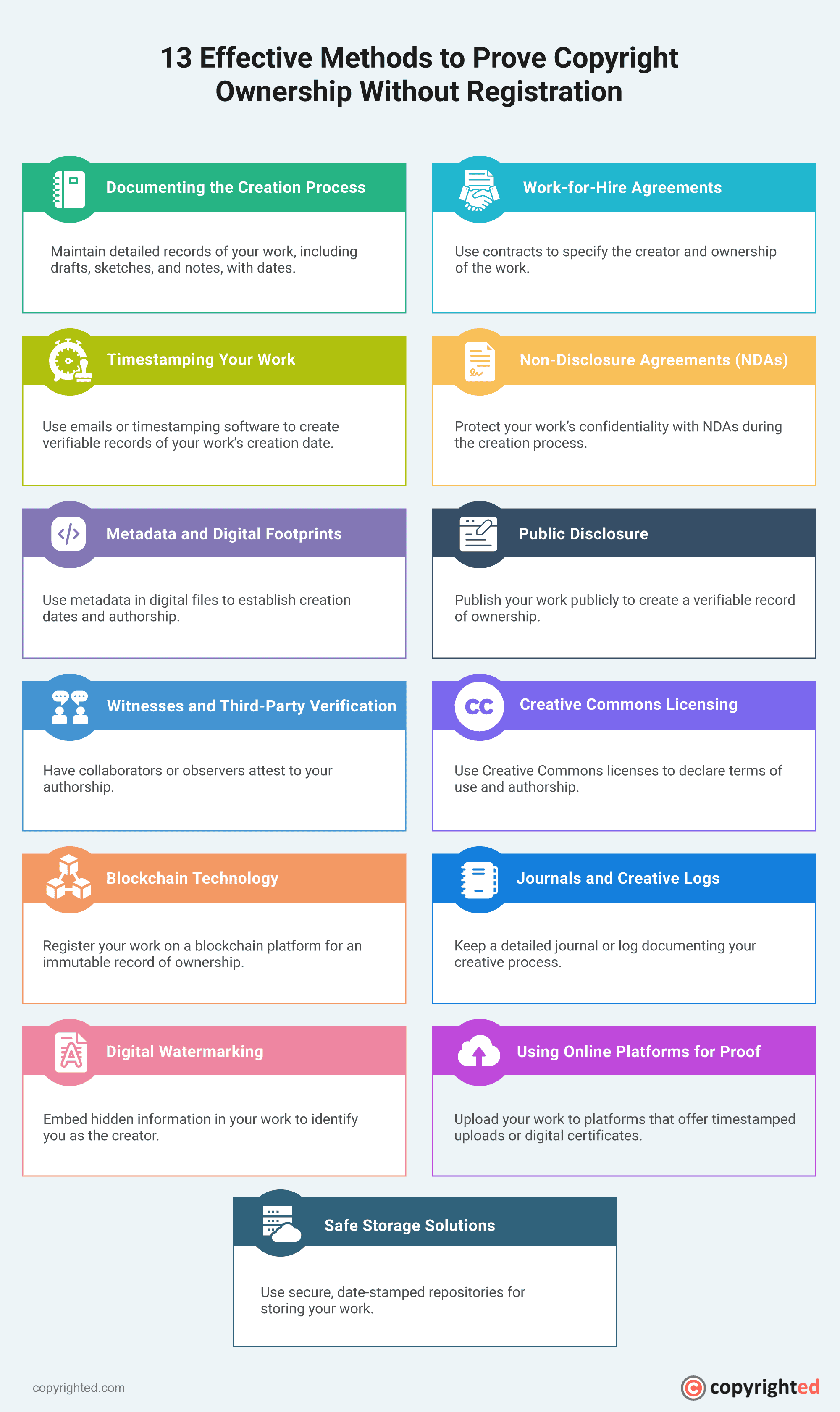Copyright ownership, along with the exclusive rights that come with it, begins as soon as an original work is created and recorded in some form. Copyright registration, on the other hand, is a formal process where the creator files their copyright with a government office, like the US Copyright Office.
While you don’t need to register to own a copyright, registration can make it easier to enforce your exclusive rights. Proving copyright ownership without registration can be tricky, but it’s possible in other ways.
- There are various ways and types of evidence to prove copyright ownership without formal registration.
- While different methods exist to establish copyright ownership without registration, creators may face challenges when relying on these alternatives.
- Registration creates a legal presumption of ownership and simplifies enforcement, making it easier to protect and defend your rights.
Table of Contents
How to Prove Copyright Ownership Without Registration?
Proving copyright ownership without copyright registration involves using various forms of evidence to establish and support your claim. Each method has its unique approach and applicability to different types of work.
Let’s discuss these methods in detail, explaining how they can be used to demonstrate ownership and providing examples where necessary.

Documenting the Creation Process
Documenting the creation process involves maintaining detailed records of your work as it develops. This can include initial drafts, sketches, notes, and subsequent revisions. These documents should be dated to establish a clear timeline, showing the progression of the work from concept to completion.
For instance, an author might keep multiple novel drafts, demonstrating how characters and plotlines evolved. Similarly, an artist could retain preliminary sketches and rough drafts of a painting.
This method applies to various creative works, including literary pieces, visual arts, music compositions, and software development.
Timestamping Your Work
Timestamping your work can be achieved through different ways, such as emailing the work to yourself or using dedicated timestamping software. This creates a record with a verifiable date and time, indicating when the work was created.
For example, a photographer might email high-resolution images to themselves immediately after taking them, creating an email record with a timestamp.
This method is particularly useful for digital works, such as articles, photographs, software code, and music files.
Metadata and Digital Footprints
Digital files often contain metadata, which includes information like the creation date, author, and any modifications made to the file. This metadata acts as a digital footprint, providing a trail of evidence that can help prove you’re the copyright owner.
For example, a digital photograph’s EXIF (Exchangeable Image File Format), the metadata embedded in digital images that includes details like the date and time the photo was taken and the camera settings used, can be used in establishing the timeline of creation.
This method is relevant for various digital works, including photographs, videos, music files, and documents.
Witnesses and Third-Party Verification
Having witnesses who can attest to your authorship or third parties who were involved in the creation process can be a powerful way to support your ownership claim. These testimonies can come from collaborators, colleagues, or anyone who observed the creation of the work.
For instance, a songwriter might have band members who can testify to their role in creating a song, or a painter might have studio assistants who witnessed the creation of a painting. This method is useful for all types of creative works, especially those created in collaborative environments.
Blockchain Technology
Blockchain technology provides an immutable and timestamped record of the creation and ownership of a work. By registering your work on a blockchain platform, you create an unalterable record that can be used to prove ownership.
For example, an artist can register their digital artwork on a blockchain, ensuring there is a permanent record of their ownership and the date of creation.
Digital Watermarking
Digital watermarking involves embedding hidden information within your copyrighted work that identifies you as the creator. This watermark can include details like your name and the date of creation.
For instance, a photographer might embed a digital watermark in their images, which can later be used to prove their ownership if the images are misused or claimed by someone else. This method is commonly used for visual and audio works, such as photographs, videos, and music.
Work-for-Hire Agreements
Work-for-hire agreements are contracts that specify the creator and the ownership of the work produced under the agreement. These contracts can clearly outline who owns the copyright to the work, providing a legal basis for your claim.
For example, a software developer might have a contract with a company that specifies the company owns the software developed under their employment. This method is relevant for works created in employment or freelance contexts, such as software, articles, and design works.
Non-Disclosure Agreements (NDAs)
NDAs can be used to protect the confidentiality of your work during the creation process. By having collaborators or third parties sign an NDA, you can ensure that they acknowledge your authorship and agree not to disclose your work without permission.
For instance, an inventor might use an NDA to protect their new product design while discussing it with potential manufacturers. This method applies to all types of creative works and helps protect your ownership rights.
Public Disclosure
Publicly disclosing your work can also serve as evidence of ownership. This includes publishing the work on a website, in a journal, or in any public forum where the date of disclosure can be verified.
For example, an author might publish a short story on their blog, establishing a public record of the date the work was created and shared. This method is useful for many works, from literary pieces to digital art.
Creative Commons Licensing
Using Creative Commons licenses lets you publicly declare the terms under which others can use your work. By choosing a specific license and attaching it to your work, you establish your authorship and set conditions for its use.
For instance, a musician might release their music under a Creative Commons license, specifying that others can use it for non-commercial purposes as long as they give credit. This method is particularly relevant for digital works and online content.
Journals and Creative Logs
Maintaining a journal or creative log where you regularly document your ideas, progress, and completion dates can help prove ownership. These logs should be detailed and dated, providing a chronological account of your creative process.
For example, a screenwriter might keep a journal documenting the development of their screenplay, from the initial concept to the final draft. This method applies to all types of creative works and serves as a personal record of authorship.
Using Online Platforms for Proof
Online platforms that offer timestamped uploads or digital certificates can provide additional proof of ownership. By uploading your work to these platforms, you create a verifiable record of the date and time it was submitted.
For instance, a graphic designer might use an online portfolio platform to showcase their work, ensuring that each upload is timestamped. This method is useful for digital works and helps establish a clear creation timeline.
Safe Storage Solutions
Storing your work in secure, date-stamped repositories can also help prove ownership. This can include cloud storage services that provide automatic timestamps for uploaded files.
For example, a songwriter might use a cloud storage service to save their recordings and lyrics, ensuring that each file is dated and securely stored. This method applies to all types of works, particularly digital content.
Challenges in Proving Ownership Without Registration
While various methods exist to establish copyright ownership without registration, creators may face several challenges when relying on these alternatives. Registration provides a legal presumption of ownership and streamlined processes for enforcement, making it significantly easier to protect and defend one’s rights.
Without registration, proving ownership can be more complex and burdensome. Here are some of the key challenges:
- Lack of Legal Presumption: Without formal registration, there is no automatic legal presumption of ownership, meaning the creator must provide substantial evidence to prove ownership in legal disputes. In contrast, registered works are presumed to belong to the registered owner, placing the burden of proof on the challenger.
- Insufficient Documentation: Over time, it can be challenging to maintain comprehensive and accurate records of the creation process. Important documents, drafts, and other forms of evidence may be lost, damaged, or incomplete, making it harder to establish a clear timeline and authorship.
- Difficulty in Authenticating Evidence: Evidence such as digital files, metadata, and witness testimonies can be contested or questioned. Opponents may challenge the validity, accuracy, or authenticity of the provided documentation, which complicates the process of proving ownership.
- Increased Legal Costs: Proving ownership without registration can lead to higher legal expenses because gathering, organizing, and presenting evidence is time-consuming and often requires legal expertise. In contrast, registered works benefit from streamlined legal processes and presumptions, which can reduce litigation costs.
- Limited Awareness and Understanding: Creators might not be fully aware of the importance of keeping detailed records or may not understand how to use the available methods to prove ownership effectively. This lack of awareness can result in insufficient preparation and weaker claims.
- Potential for Disputes: In collaborative environments, multiple parties may contribute to creating a work, leading to potential disputes over ownership. Without clear agreements or documentation, resolving these disputes can be challenging and contentious.
- Technological Challenges: Relying on digital evidence such as metadata or blockchain records requires a certain level of technological literacy. Creators unfamiliar with these technologies may struggle to implement and use them effectively to prove ownership.
- Risk of Incomplete Evidence: Evidence such as drafts, digital files, and correspondence may be lost, damaged, or incomplete. Over time, it may become harder to compile comprehensive and convincing proof of ownership, particularly if the work was created many years ago.
By understanding and addressing these challenges, you can better prepare yourself to protect your intellectual property and effectively prove your ownership, even without formal registration.
Frequently Asked Questions
Can you claim copyright ownership without registering your work?
Yes, copyright ownership automatically applies when an original work is created and fixed in a tangible medium. Registration is not required for ownership but provides additional legal benefits.
What should you do if someone infringes your unregistered copyright?
Gather evidence of your ownership, send a cease and desist letter, consult an attorney, consider registering your work, and, if necessary, file a lawsuit to protect your rights.
What is a poor man’s copyright, and is it effective?
A “poor man’s copyright” involves mailing a copy of your work to yourself to create a dated record. It is not legally recognized and is generally ineffective in court compared to formal registration.
How can witness testimonies support your claim of copyright ownership?
Witness testimonies from individuals who observed the creation of your work can verify your authorship and support your ownership claim. Detailed and credible testimonies strengthen your case.
Can social media posts be used as proof of copyright ownership?
Yes, social media posts can serve as proof by providing a public record with a timestamp, establishing the date of creation, and public disclosure.


